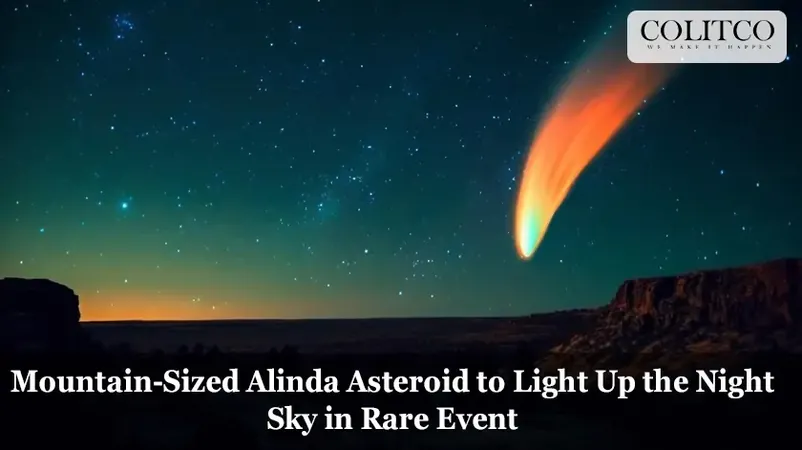
Don't Miss the Majestic Alinda Asteroid – Here's How to Witness This Celestial Wonder!
2025-01-12
Author: Benjamin
A Close Encounter Like No Other
Measuring approximately 2.6 miles (4.2 km) wide, the Alinda asteroid is set to make its closest approach to Earth in decades. Last seen at this proximity in the 20th century, it won’t return until 2087. With an estimated peak brightness of magnitude 9.4, Alinda won’t be visible to the naked eye, but it can easily be observed with stargazing binoculars or a backyard telescope.
Viewing Details
Mark your calendars for Sunday, January 12! The asteroid will traverse through the constellation Gemini, becoming observable in the Northern Hemisphere just after sunset and remaining in view throughout the night. For those without access to stargazing gear, the Virtual Telescope Project will provide a free livestream on their official YouTube channel, commencing at 12:30 PM EST on January 12.
Unveiling the Rarity of This Event
Astronomers describe Alinda’s flyby as a “once in a decade” occurrence. Notably, it is among the five largest asteroids set to pass within 9.3 million miles (15 million km) of Earth before the year 2200.
Is Alinda a Threat?
Despite its colossal size, Alinda poses no danger to Earth during this flyby. NASA has confirmed that no known asteroid, including Alinda, will come anywhere near Earth for at least a century. However, due to the potential devastation if it were to collide with Earth, Alinda is classified as a “planet killer.” This classification underscores the need for continued advancements in planetary defense strategies.
The Quest for Planetary Defense
NASA recently achieved a landmark milestone with its Double Asteroid Redirection Test (DART) mission, effectively demonstrating the feasibility of deflecting an asteroid by crashing a spacecraft into it. If an asteroid like Alinda ever deviated toward Earth, experts assert it would likely take hundreds of rockets to break the space rock into smaller, less harmful fragments. Preparing for such a defense mission would require years, if not decades, of meticulous planning.
China is also making strides in planetary defense, with plans to launch its asteroid deflection mission by 2030, contributing further to global efforts aimed at safeguarding Earth against potential asteroid threats.
Upcoming Stargazing Spectacles
But mark your calendars not just for Alinda! Astronomy enthusiasts can look forward to a remarkable month ahead. On Monday, January 13, the full Wolf Moon will rise near Mars, creating a rare occultation event as Mars slips behind the moon for four hours. From January 21, a mesmerizing planetary alignment will allow Venus, Mars, Jupiter, and Saturn to be visible to the naked eye, with Uranus and Neptune observable through telescopes, and Mercury joining the display in early March.
The Significance of Alinda’s Visit
The visibility of asteroid 887 Alinda not only promises an extraordinary visual experience but also serves as a pivotal reminder of the importance of monitoring near-Earth objects. Such events fuel scientific curiosity and drive advancements in aerospace technology and planetary defense.
Whether you’re watching with binoculars or joining the livestream from the comfort of your home, don’t miss this rare chance to witness a piece of our solar system’s history. Alinda’s flyby is an event that promises not just awe, but also inspiration for future explorations of our cosmic neighborhood. Prepare to be amazed—this celestial encounter is truly one for the books!



 Brasil (PT)
Brasil (PT)
 Canada (EN)
Canada (EN)
 Chile (ES)
Chile (ES)
 Česko (CS)
Česko (CS)
 대한민국 (KO)
대한민국 (KO)
 España (ES)
España (ES)
 France (FR)
France (FR)
 Hong Kong (EN)
Hong Kong (EN)
 Italia (IT)
Italia (IT)
 日本 (JA)
日本 (JA)
 Magyarország (HU)
Magyarország (HU)
 Norge (NO)
Norge (NO)
 Polska (PL)
Polska (PL)
 Schweiz (DE)
Schweiz (DE)
 Singapore (EN)
Singapore (EN)
 Sverige (SV)
Sverige (SV)
 Suomi (FI)
Suomi (FI)
 Türkiye (TR)
Türkiye (TR)
 الإمارات العربية المتحدة (AR)
الإمارات العربية المتحدة (AR)